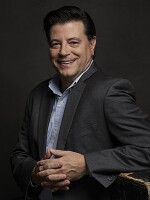For most of the fall semester, the University of Hartford’s Silpe Gallery has been an art exhibition space and part giant quilting circle.
Iranian artist Minoo Emami was in the gallery preparing for a daring, almost unthinkable piece of performance art. On Nov. 11, Veterans Day, Emami destroyed 22 of her paintings by fire, including early works dating back to 1998. Many of the paintings depict artificial limbs in whimsical, but sometimes surreal and dark settings.
“I love my paintings, you know, don't take me wrong,” Emami said. “But compared to veterans, veteran’s families, and what they lose? It's nothing.”
With help of volunteers, mostly UHart students, the paintings were sewn on a giant, black quilt. The quilt was stitched together using surgical sutures, another important element of the work. Emami taught project volunteers how to sew this way.
“I give them a demo of suturing, actually like the surgeon stitches,” Emami said. “So they suture the canvas to the quilt. And there's small cuts in the paintings and all of them have body parts, so they suture the canvases as well.”
“The sewing really felt like such an act of care, because of the intention behind it, how careful the process was,” said University of Hartford student Alison Bakke, who helped Emami stitch the quilt. “So, even though the paintings will be destroyed, it's almost like this ultimate act of grief in destroying them. It's an act of love, by letting them go and letting them transform into something else.”
For Emami, the art burning is a “ritual rooted in mourning.”
“Because deep in my heart, I am mourning,” Emami said. “I'm mourning for all the young Iranians who have been hurt during the past 45 years, and especially during the past year, and also for all families, everyone young and old who have been hurt with war and violence around the world in past years.”
Last Saturday, on a chilly but sunny afternoon at the Harry Jack Gray quad on the campus of the University of Hartford, Emami unveiled her performance piece: “A Fire for Peace.”
Emami and eight women, dressed in black, carried out a series of “mourning rituals based on Kurdish traditions,” according to the performance program. One ritual involved rubbing mud into each other’s clothing.
As Emami sang songs throughout, each member of the ensemble ritualistically doused the giant quilt with paraffin oil. The oil was poured from traditional tear catching vessels, made by Emami.
A quartet of West Hartford firefighters set the quilt on fire. It burned brightly and briefly before they doused it with water.
Learn more
Listen to an audio postcard from the performance. (Click the "listen" button above.)
It’s not too late to learn more about Minoo Emami. A retrospective of her art is on exhibition at UHart’s Joseloff Gallery. “Minoo Emami: Under My Veil” runs through Dec. 16.











